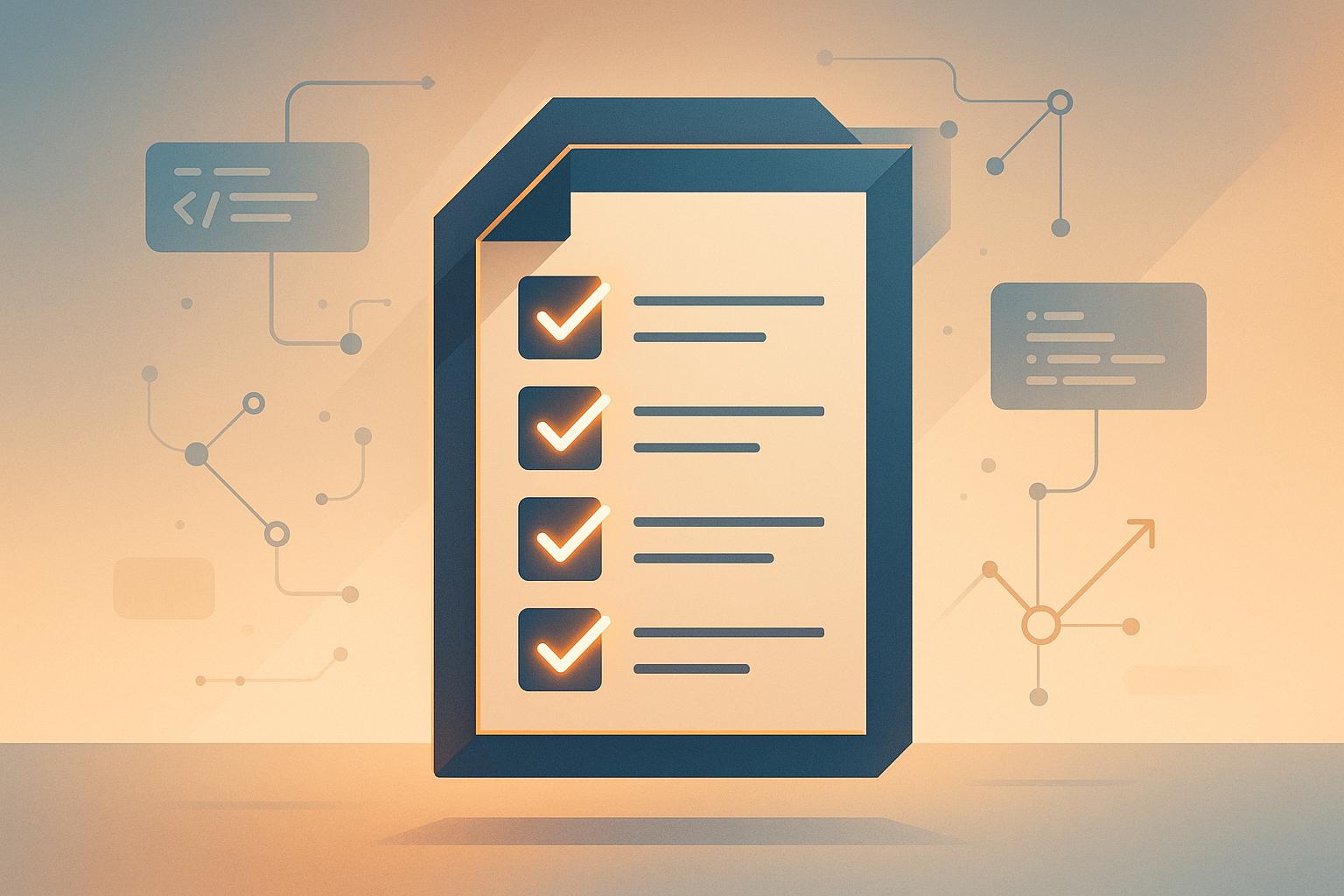


Learn how behavioral targeting can enhance marketing strategies for developers by tailoring content and ads based on their actions and preferences.
Behavioral targeting is about understanding what users do rather than just who they are. For developers, this means tailoring ads and content based on actions like coding habits, tool usage, and learning preferences. Why does this matter? Because developers value relevance and precision, and generic campaigns just don’t work.
Here’s what you’ll learn:
- What is behavioral targeting? It uses data like browsing history and tool preferences to create personalized marketing.
- Why does it work for developers? Developers engage more with ads that match their technical needs and career stages.
- How can you apply it? Platforms like daily.dev Ads help businesses use behavioral insights to target over 1 million developers with precision.
Key Takeaways:
- Behavioral targeting improves ad engagement and click-through rates (CTR), with retargeted ads performing 10x better than standard ones.
- Developers prefer content tailored to their programming languages, seniority, and project phases.
- Privacy compliance and first-party data collection are essential for building trust with this audience.
Behavioral targeting isn’t just effective - it’s necessary for creating meaningful connections with developers. Platforms like daily.dev Ads make it easier to implement this strategy and see measurable results.
What is Behavioral Targeting? | Marketing Analytics for Beginners | Part-23
Core Components of Behavioral Targeting
Grasping the essentials of behavioral targeting is crucial for crafting campaigns that genuinely connect with developer audiences. This approach provides a detailed view of how developers engage with content and technology, forming the foundation for campaigns that truly resonate.
Key Data Sources for Behavioral Targeting
Behavioral targeting relies on several types of data: first-party data gathered from direct user interactions, second-party data from trusted partnerships, and a decreasing reliance on third-party data. This shift highlights the growing importance of user-consented information.
As Jon Palmer, Lead Product Marketing Manager at Klaviyo, points out:
"The market is moving away from third-party data".
This change underscores the need to focus on robust first-party data strategies. Tools like browser cookies, tracking pixels, mobile usage events, and device IDs help track user behavior across platforms.
By 2023, 81% of global digital ad spending was executed programmatically, showcasing the dominance of data-driven targeting. Prioritizing zero- and first-party data - where users willingly share their information - has become essential. Lucina Kress Rowe, Principal Customer Success Manager at Klaviyo, explains:
"With first-party data, people have opted in. They've explicitly told you, 'Yes, I'd like to receive your messages.' And that makes for smarter communications".
Tapping into these data sources is critical for uncovering meaningful insights into developer behavior.
Developer Behavioral Insights
Using these data sources, businesses can decode the unique behaviors of developers, enabling more precise targeting. Developers engage with content in ways that set them apart from general audiences. Their interactions with technical articles, tutorials, coding forums, and GitHub contributions reveal their expertise and focus areas.
For example, developers' tool usage patterns can highlight their preferences for specific environments, frameworks, or libraries - offering clues about their workflows and needs. Similarly, their learning habits and career progression can indicate where they are in their professional journeys. Even their search behaviors, like troubleshooting error messages or debugging techniques, provide actionable insights.
Jon Palmer of Klaviyo emphasizes this comprehensive approach:
"Behavioral targeting means taking the entirety of customer behavior, and personalizing communication based on that".
For developers, this means considering their coding habits, preferred learning methods, career aspirations, and technical interests as interconnected factors. Timing is also key. Developers may focus on researching tools during project planning and then shift to implementation resources during development. Understanding these cycles allows businesses to deliver campaigns that align with developers' needs at the right moment.
Privacy and Compliance Requirements
As methods for data collection grow, so does the importance of privacy compliance - especially when dealing with developers, who are often highly aware of data privacy issues. Transparency is crucial. Companies must clearly explain what data they collect, how it will be used, and who it will be shared with to earn trust.
Managing user consent is no longer optional. Ken LaMance, Attorney & General Counsel at LegalMatch, states:
"Consent management is no longer a nice-to-have; it's a must-have for businesses operating online today".
Laws like the California Consumer Privacy Act (CCPA) and other state-level regulations require businesses to provide users with rights to access, update, and delete their personal data, as well as to opt out of data processing for marketing purposes. Regulatory actions in 2023 have reinforced the necessity of secure, consent-based practices.
Strong data security measures - such as encryption, secure transmission protocols, and strict access controls - are essential. These practices are not just about compliance; they address consumer concerns, as 64% of people have avoided products or services due to data privacy worries.
Adopting data minimization strategies, which limit the collection and storage of unnecessary personal information, can reduce compliance risks. Regular audits and employee training are also vital for maintaining trust and avoiding legal complications.
Effective Segmentation Strategies for Developer Audiences
Developers require segmentation approaches that align with their distinct behaviors and decision-making processes. Let's explore how to create actionable segmentation strategies tailored to this unique audience.
Behavioral vs. Demographic Segmentation
When it comes to targeting developers, deciding between behavioral and demographic segmentation can make or break a campaign. In fact, 77% of marketing ROI stems from segmented, targeted, and triggered campaigns. This makes choosing the right approach a critical step.
Demographic segmentation focuses on static traits like age, education, or job title. While this method works for broad audiences, it often falls short for developers who may share similar backgrounds but exhibit vastly different technical interests and behaviors.
Behavioral segmentation, however, digs deeper. It analyzes how developers interact with technology, tools, and content, uncovering patterns like coding habits and technology adoption cycles. This approach leads to more effective campaigns.
| Feature | Demographic Segmentation | Behavioral Segmentation |
|---|---|---|
| Basis of segmentation | Age, gender, income, education, marital status, ethnicity | Interactions with products/services, such as purchase history and engagement levels |
| Data Collection | Surveys and demographic data | User activities, including online behavior tracking and transaction histories |
| Marketing Strategy | Broad targeting based on general profiles | Personalized marketing based on behavior and preferences |
| Key Focus Area | Who the customers are | What the customers do |
| Depth of Insight | Surface-level insights based on visible traits | Deeper understanding of customer intent and motivations |
| Actionability | Static insights, less actionable | Actionable insights that influence strategies |
The advantages of behavioral segmentation stand out when you consider that 80% of companies using segmentation report increased sales.
Segmenting by Developer Types
To segment developers effectively, it's essential to understand the technical environment that shapes their work. Programming languages are a reliable starting point, as they reflect developers' ecosystems, tools, and communities.
Technographic segmentation - analyzing technology usage like devices, software, or apps - is particularly effective for targeting developer audiences. Platforms like daily.dev Ads utilize this method to focus on developers' tech stacks and seniority. For instance, a JavaScript developer working with React has entirely different needs from a Python developer specializing in machine learning, even if their demographics overlap.
Developers' roles also create natural segmentation. Frontend developers engage with different tools and content compared to backend developers or DevOps engineers. Furthermore, professional seniority adds another layer of insight:
- Junior developers seek beginner-friendly tools and educational content.
- Senior developers focus on advanced techniques, architecture, and team management.
- Principal engineers and technical leads explore enterprise-grade tools and make strategic decisions.
By targeting developers based on their programming languages, seniority, and specific interests, platforms like daily.dev Ads ensure campaigns are highly relevant and well-timed for engagement.
Using Engagement Patterns for Segmentation
Beyond technical attributes, engagement patterns provide real-time insights into developers' interests and readiness to adopt new solutions. For example, frequent engagement with specific technologies signals active interest, while learning format preferences reveal how developers consume content. Some may prefer hands-on tutorials, while others gravitate toward detailed documentation or video guides.
Event participation is another valuable indicator. Developers attending conferences, webinars, or meetups are often early adopters and influencers within their communities. These behaviors can identify individuals likely to drive broader adoption of tools or technologies.
RFM analysis (recency, frequency, monetary value) is another effective tool for segmentation. Recent purchasers may be open to complementary solutions, while frequent buyers are prime candidates for loyalty programs. Timing also plays a role - developers researching solutions during project planning phases have different needs than those troubleshooting immediate issues. Tailoring messaging to these contexts ensures more relevant communication.
Real-world examples highlight the impact of behavioral segmentation. In 2025, JOBKOREA, a South Korean career platform, used dynamic behavioral segments to achieve a 4-5X boost in click-through rates (CTR) and higher conversions. Similarly, Too Good To Go analyzed app sessions and purchase behaviors, leading to a 135% increase in purchases and doubling message conversion rates.
These cases demonstrate how understanding behavioral patterns can lead to measurable success. For developers, this means looking beyond surface characteristics to identify deeper signals of interest and intent.
sbb-itb-e54ba74
Personalizing Campaigns with Behavioral Data
Once you've segmented developers based on their behavior, the next step is to turn those insights into tailored campaigns. Research shows that 80% of consumers are more likely to make a purchase when brands provide personalized experiences. Developers, in particular, appreciate relevance and efficiency in the tools they use, making personalization a key strategy.
Best Practices for Personalization
74% of customers express frustration when they receive marketing content that doesn’t align with their interests. This frustration is even more pronounced among developers, who are quick to tune out irrelevant messaging.
Effective personalization begins with detailed behavioral profiles that highlight how developers interact with tools, their pain points, and where they are in their learning journey. The payoff? Real-time personalization can deliver a 667% ROI. For example, you can tailor content to match a developer's project phase, recent searches, or engagement with specific tools.
Take Amazon's "Customers who bought this also bought" feature - it’s a classic example of using past behavior to recommend complementary products. For developer campaigns, this could mean suggesting related tools, frameworks, or learning resources based on their current tech stack.
Consistency is another critical factor. Developers engage with content across various channels, such as technical blogs, documentation, social media, and email newsletters. To build trust, your messaging needs to stay aligned across all these touchpoints.
Netflix is another master of behavioral personalization. 60% of its rentals come from personalized recommendations based on viewing history. Similarly, developer campaigns can use past interactions to predict and deliver relevant content, such as conference sessions, technical articles, or product demos.
These strategies lay the groundwork for daily.dev Ads to provide highly tailored and impactful campaigns.
Using daily.dev Ads for Personalization

daily.dev Ads takes personalization to the next level with hyper-native, adaptive ad placements that deeply resonate with developers. With over 1 billion platform interactions and 40% power users, the platform offers a treasure trove of behavioral data for precise targeting.
Its hyper-native ad placements seamlessly integrate into developers’ daily routines. In-feed native ads blend naturally into their content consumption, while post-page ads target users already engaging with specific technical topics. Upcoming personalized digest ads will take this further by delivering tailored content recommendations based on individual reading habits.
The platform’s targeting capabilities are unmatched, allowing campaigns to focus on seniority levels, programming languages, or specific developer tools. For instance, a campaign promoting a JavaScript framework can target developers actively consuming JavaScript-related content while excluding those focused on other languages. Similarly, DevOps tools can be marketed to developers interacting with Docker, Kubernetes, or similar technologies.
daily.dev Ads also supports diverse objectives, from product adoption and brand awareness to event promotion and lead generation. Each goal can be customized with unique messaging, creative assets, and calls-to-action, all rooted in developers’ behavioral profiles.
The platform ensures a trusted environment where brands can connect with developers effectively. This trust helps enhance the impact of personalized campaigns, as developers are more likely to engage with relevant content on platforms they already value.
Dynamic Content and Retargeting
Dynamic content and targeted retargeting allow you to fine-tune your messaging, visuals, and offers in real time, based on developers’ specific needs. This could mean showcasing different code examples, use cases, or pricing options depending on factors like company size, experience level, or technology preferences.
Leesa’s story is a great example of how dynamic personalization can transform campaigns. By adopting a headless CMS, the company tracked user interactions, logged related topics, and delivered targeted offers and recommendations. This approach directed users to personalized product pages.
"Thanks to Contentstack's Modular Blocks, we've really upped our game when it comes to personalization." - Richard Bilton, Director of Technology, Leesa
For developer-focused campaigns, this strategy can highlight relevant documentation, tutorials, or integration guides based on a user’s past interactions and current interests.
Retargeting is another powerful tool. For example, a developer who recently explored microservices architecture might see ads for container orchestration tools. Similarly, someone researching frontend frameworks could receive content about performance optimization techniques.
Managing all these variables can feel overwhelming, but modern platforms make it easier. As Jana Teuber from Taxfix explains:
"We work with a lot of variables - more than 300. It's very complex, but now with Contentstack it's way easier to keep all the content up to date."
Personalization has the potential to boost marketing ROI by five to eight times and increase sales by 10% or more. For developer campaigns, investing in behavioral data and dynamic personalization leads to higher engagement, better conversion rates, and stronger relationships with the developer community.
Start simple by focusing on clear behavioral signals like technology preferences and engagement patterns. Then, gradually layer in more sophisticated elements, such as project phases, team roles, and decision-making authority, as your data grows.
Measuring and Optimizing Behavioral Targeting Campaigns
Crafting personalized campaigns is just the beginning - measuring and fine-tuning them is what ensures lasting engagement with developers. By focusing on the right metrics, you can separate high-performing campaigns from those that fall flat. These metrics should reflect developers' unique habits and decision-making processes, forming the backbone of a strategy that delivers results.
Key Metrics for Behavioral Targeting
Click-through rate (CTR) is a core metric for determining how relevant your campaign is. According to data from developer-focused campaigns on daily.dev's platform, the average CTR sits at 2.5%, with top-performing campaigns reaching 3.5%.
Conversion rate provides a deeper look at how effective your campaign is at driving action. For developer tools and services, where decisions often follow extensive research, the average conversion rate is 1.5%, with top campaigns achieving 2.5%.
Cost per click (CPC) directly affects your campaign's profitability. On daily.dev's platform, the average CPC is $0.50, but optimized campaigns can bring this down to $0.30, making your budget stretch further.
Engagement depth goes beyond surface-level metrics, tracking how developers interact with your content post-click. Metrics like time spent on landing pages, documentation downloads, GitHub visits, or trial sign-ups can help pinpoint the most engaged users - those likely to become long-term customers.
Attribution windows should account for the extended evaluation periods developers often need when adopting tools. A 30–90 day window is more realistic for capturing the full decision-making process.
Behavioral cohort analysis helps you understand how different segments respond to your campaigns. By analyzing performance across variables like experience level, programming language, or company size, you can identify and prioritize your most valuable audiences.
Tools and Techniques for Optimization
A/B testing is particularly effective with developer audiences. Test variations like technical messaging versus business-oriented benefits, or code examples versus feature lists. Regular testing ensures your campaigns evolve alongside developer preferences.
Real-time analytics dashboards give you the ability to spot trends as they happen and adjust campaigns on the fly. Monitoring metrics like engagement with documentation or trial usage can help you address potential issues before they grow.
Lookalike audience creation allows you to scale by targeting developers who mirror your best-performing segments. Instead of relying solely on demographics, use detailed behavioral data to build these audiences.
Bid optimization involves constant tweaking based on real-time performance data. Set clear goals for your bidding strategies and adjust as needed. For example, lowering bids can free up budget for data collection, helping you expand your reach - especially in automated campaigns.
Regular data audits are essential to ensure accuracy and keep your optimizations effective.
The most successful campaigns blend multiple strategies rather than relying on just one. Start with precise audience segmentation, then scale with lookalike modeling and refine with behavioral retargeting.
Personalization remains a key driver of success. Research shows that 76% of consumers are more likely to purchase from brands that personalize their marketing efforts. For developers, this is even more critical, as they value relevance and efficiency when choosing tools.
Sophisticated behavioral analysis can also yield impressive results. For instance, McKinsey reports that 35% of Amazon's sales come from recommendations based on prior behavior. The same principle applies to developer marketing: understanding past interactions helps predict future needs.
To stay effective, continuously update your audience segments to align with shifting developer preferences and technological advancements. This ensures your targeting remains relevant and avoids becoming outdated.
Ultimately, success lies in creating a system that adapts and improves over time. By combining behavioral insights with technical know-how, you can craft campaigns that not only connect with developers but also drive measurable outcomes for your business.
Conclusion: Getting the Most from Behavioral Targeting for Developers
Behavioral targeting shifts the focus from broad demographic-based advertising to a more refined approach centered on user actions and preferences. For businesses looking to engage developer audiences, this strategy offers a way to foster stronger, measurable connections. It builds on core principles of segmentation and optimization to deliver results that resonate.
Real-world examples highlight the power of behavioral targeting. Adidas, for instance, saw a 259% increase in average order value from new users and a 35.3% boost in conversion rates from returning customers by using targeted coupon codes informed by behavioral insights. Similarly, U.S. Polo Assn. achieved a 311% rise in conversion rates and a 135% improvement in return on ad spend by using predictive targeting to identify customers with high purchase intent. These outcomes emphasize how this approach works across industries.
For developer marketing, the distinction between demographic and behavioral data is key. Demographics tell you who developers are, but behavioral data uncovers what they do and when they’re most likely to engage. This deeper understanding allows campaigns to connect with developers in ways that feel relevant and timely.
Platforms like daily.dev Ads bring this concept to life by offering access to over 1 million developers. With targeting options based on programming languages, seniority levels, and specific tools, the platform ensures your campaigns are reaching the right developers at the right moments.
To maximize results, combine precise segmentation with dynamic retargeting. Start by segmenting your audience based on real developer behaviors, then scale with lookalike modeling to find similar high-value prospects. Use real-time performance data and A/B testing to fine-tune your messaging, ensuring it aligns with developers’ evolving needs and preferences.
Personalization also plays a critical role. Companies that excel at personalization generate 40% more revenue from their marketing efforts compared to their competitors. In the developer space - where trust and relevance are non-negotiable - behavioral targeting is a cornerstone for creating meaningful, lasting connections.
The future of developer marketing lies in delivering the right message to the right developer at the right time. With behavioral targeting powered by tools like daily.dev Ads, achieving this level of precision at scale is not just possible - it’s essential for long-term success.
FAQs
What’s the difference between behavioral targeting and demographic targeting, and why is behavioral targeting better for connecting with developers?
Behavioral targeting zeroes in on what users actually do - such as their browsing habits, interaction patterns, and preferred tools. In contrast, demographic targeting sticks to fixed traits like age, gender, or income. For developers, behavioral targeting tends to be far more effective, as it delivers ads tailored to their real interests and activities - think programming languages they work with or the tools they frequently explore.
By focusing on these behaviors, this method drives higher engagement and improves conversion rates because it directly addresses developers' unique needs and preferences. Demographic targeting, however, often overlooks these nuances, making it a less precise way to connect with such a specialized group.
How can businesses ensure privacy compliance when using behavioral targeting?
To use behavioral targeting responsibly while staying compliant with privacy laws, businesses should focus on obtaining clear and informed consent from users. This means explaining data collection practices in plain, straightforward language and ensuring users have simple, accessible options to opt out whenever they choose.
It's also crucial to put strong data protection measures in place. This includes encrypting sensitive data, restricting access to authorized personnel, and regularly auditing how data is collected and stored. Being transparent is non-negotiable - keep a detailed and up-to-date privacy policy, and honor user preferences, such as 'Do Not Track' signals, to foster trust and meet legal requirements.
By adopting these steps, businesses can effectively use behavioral targeting while respecting user privacy and staying within the boundaries of data protection regulations.
How can businesses use first-party data to create personalized marketing campaigns for developers?
Businesses can tap into first-party data to create marketing campaigns that feel tailor-made for developers. By understanding developers' behaviors, preferences, and the tools they rely on, companies can deliver content and recommendations that genuinely align with their unique needs and interests.
To make this work, a few strategies stand out. First, it's crucial to maintain high-quality data - accurate and up-to-date information is the backbone of any effective campaign. Next, segment developers into groups based on their interests or skill levels. This helps in crafting messages that speak directly to each group. Finally, predictive analytics can be a game-changer, allowing businesses to anticipate what developers might need next. When done right, these efforts can lead to higher engagement, stronger trust, and deeper connections with the developer community.






